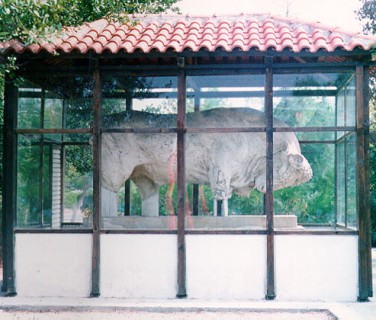
Bull of the Oreoi
5.0
Sight
The Bull of the Oreoi was found in 1965, at sea, at a depth of 2.5 meters, during port expansion works. During the looting of Oreos by Attalos (199 BC), the golden horns and the front legs of Bull were removed and the remaining massive marble sculpture could not be loaded onto a ship and abandoned. Its installation on the podium was completed in 1966.
It is a full-size, all-round offering that represents the bull in attack. It is made of white marble and weighs about 4.8 tones. It is one of the largest in volume and weight sculptures found in Greece. The dimensions of the surviving sculpture are 3.20 meters long, 1.30 meters high and 0.75 meters wide.
The sculpture is preserved almost intact, with the exception of the inserted horns (which were made of other material, possibly marble or gold), the tail section and the legs that have been broken from the thigh and down (possibly because they did not have the same strength) with the solid rest of the body (upon its fall into the sea).
The sculpture is displayed in a glass canopy behind the Temple of the Demetrius, near the port of Oreoi.
Its construction is dated to the end of 4th - early 3rd BC. century. Possibly, he was decorating a funeral monument of a prominent Oreoi. Another version is that it was the symbol of the ancient city while other scholars associate it with the existence of a sanctuary in the area, considering the dedication of Demetrius the Conqueror with clear pictorial political meaning (at the time of Bull construction there was prosperity and the Evian unite by having common laws, government, and even coins). The bulls motif is also related to the Dionysian cult, and since Dionysus was worshiped in northern Evia, the statue may also be related to the worship of the god.













